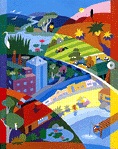
The Web of Life


The Web of Life

| Biodiversity is the web of life - the thin skin of
living things, including us, which inhabits the surface of planet Earth. Biodiversity
includes humans, animals, plants, fungi and microbes - from dugongs to daisies, toadstools
to termites. This variety of life has evolved over hundreds of millions of years. We don't
know how many species live on Earth - scientists have described about 1.8 million. But
that's just a drop in the ocean compared to the estimated 10 to 100 million which probably
exist. Yet what has taken millions of years to evolve is now being destroyed at a breathtaking rate. Dr Harry Rechter who chairs the National Biodiversity Council recently estimated we could be losing eight species an hour, or 70,000 a year world-wide. That's a faster rate of extinction than at any time since the dinosaurs died out 65 million years ago. Yet plants and animals today are not dying out because of a maverick meteorite. Rather, it is the actions of our own species, clearing natural habitats, spreading pest plants and animals, and dumping pollutants into the rivers, oceans and atmosphere. A group of independent Australian experts recently identified biodiversity loss as "perhaps the most serious environmental problem in Australia today" and "a cause for national concern". They said species in all major groups of plants and animals are at risk. (State of the Environment Advisory Council State of the Environment Report 1996). Since European settlement of Australia, 10 out of 144 species of marsupials have become extinct with unknown numbers of invertebrates and lower order creatures. We have lost three species of emu - the King Island, Kangaroo Island and mainland Tasmanian emus are all extinct. Today more than 100 mammal species are endangered, vulnerable or potentially vulnerable. Forty per cent of Australia's forests are gone, including 75 per cent of our rainforests, leaving many forest ecosystems also endangered. Biodiversity is our living heritage, providing us with food, clothing, housing clean air and water, inspiration and spiritual renewal. It's an integral part of our lives, and it's easy to see that protecting biodiversity today will pay off for the future health of human society, our economy and all life on Earth. Yet how can we benefit from it without destroying it? As we look around we know that biodiversity is under threat, yet often it seems there is little any individual can do. We can become frustrated and feel helpless that the problem is just too big to tackle. Hopefully this web site will give you some ideas and some hope for the future. This section of my environment web site is based upon a booklet produced by the Department of the Environment and Heritage, Environment Australia. This material can be freely reproduced for non-commercial purposes provided Environment Australia is acknowledged. Their logo appears at the bottom of this page. |
Now take a tour of my Biodiversity Web.
![]() 20 Ways to Protect Biodiversity
20 Ways to Protect Biodiversity
![]() In the Backyard and Beyond
In the Backyard and Beyond
![]() Food, Health, Farms
Food, Health, Farms
![]() On Holiday and on the Water
On Holiday and on the Water
![]() Warning: Signs of Change
Warning: Signs of Change
![]() Links and Resources
Links and Resources
![]() Biodiversity Home Page
Biodiversity Home Page
![]() Back to the Environment Site Map
Back to the Environment Site Map
![]() E-mail me
E-mail me
Biodiversity material from:
